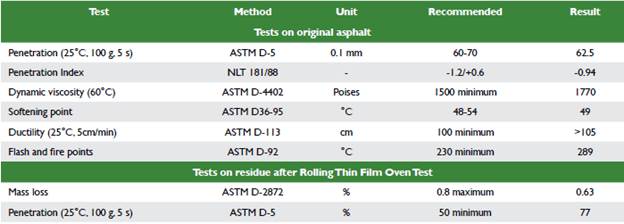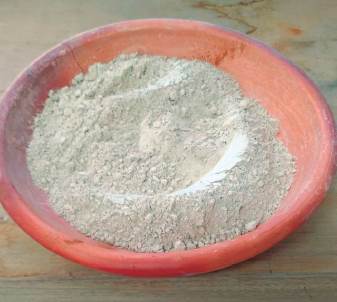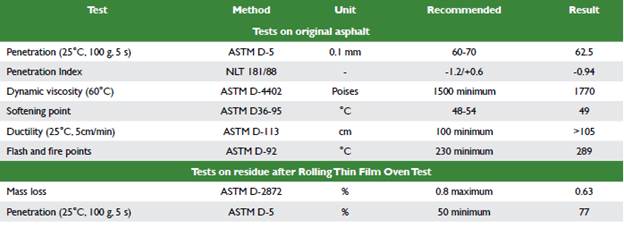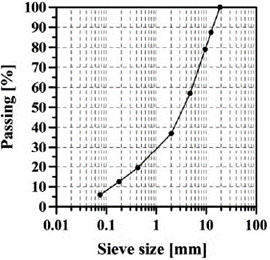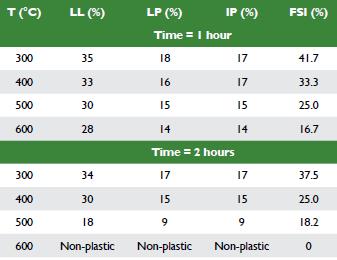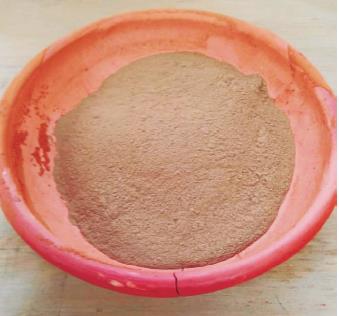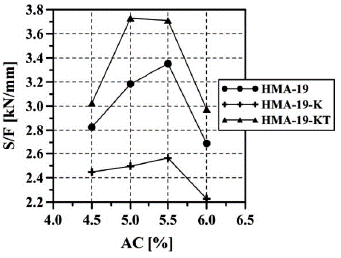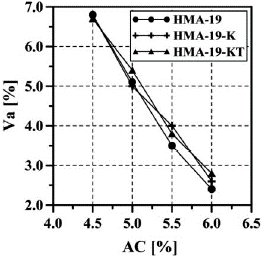Clay soils, abundant in nature, are undesirable during road construction because they generally have low bearing capacities and shear strength, expand and to develop plastic behavior in the presence of water. They are usually discarded and sent to landfills, which negatively impacts the environment. On the other hand, the natural mineral filler used to produce asphalt mixtures is difficult to obtain because it is made up of particles whose sizes are less than 0.075 mm (passes sieve No. 200 in gradation test). In some cases, aggregates must be crushed to obtain filler, and this increases the cost of production and the consumption of energy.
Discarded clay soils can be used for many purposes including the manufacture of masonry, bricks (Abu-Zreig et al., 2001), ceramics (Yanti & Pratiwi, 2018) and geo-polymers (Elimbi et al., 2011). In this study is presented the possibility of using heat-treated industrial kaolin as a filler in hot mix asphalt (HMA). Kaolin was subjected to high temperatures in order to eliminate its undesirable plastic and expansive behaviors that can negatively affect asphalt by decreasing resistance to moisture damage and stripping (Wasilewska et al., 2017). Industrial kaolin was chosen because this mineral is abundant in layers of clay soil but is more homogeneous than natural clays. This characteristic reduces the number of variables needed for evaluation.
A literature review found no studies of the use of thermally treated clays as fillers in asphalt mixtures. Some specially treated clays have been used as nano-materials for modifying the characteristics of asphalts (called nano-clays, Siddig et al., 2018). Several authors have found that incorporation of different proportions of nano-clays into asphalt has led to improvements in physico-mechanical properties of asphalt mixtures such as increased resistance to rutting (Yu et al., 2007), resistance to cracking at low temperatures (Zare-Shahabadi et al., 2010) and resistance to fatigue (Ziari et al., 2014). Other authors have also reported satisfactory behavior of different types of treated clays in asphalt mixtures (Al Allam et al 2016, Mohd-Satar et al., 2018). These include clays previously stabilized with lime and then used in asphalt mixtures (Alizadeh and Modarres, 2019), synthetic coarse aggregate of calcined clay (SCACC) manufactured at high temperatures and used to replace the coarse fraction of asphalt mixtures (Lopes da Silva et al., 2015; De Souza Campelo et al., 2017, 2018; Losa et al., 2008), and waste bleaching clays from the food industry used as filler in asphalt mixtures (Sangiorgi et al. 2014, 2016). The last material did not have the typical properties of clay minerals. Bani-Baker et al. (2018) used a bentonite mixed into the mineral filler in proportions of 5, 10, 15, 20, 25 and 30% (by total weight of its portion of total aggregates). The bentonite, which is a highly plastic and expansive material, was not heat-treated which may have resulted in undesirable long-term effects on the properties of the mixtures, but this was not evaluated.
Materials and Methods
Asphalt concrete type HMA-19 (INVIAS, 2013) was chosen as the control material since in Colombia it is the type most commonly used for construction of surface or binder course asphalt layers of flexible pavements. For its manufacture, asphalt cement (AC) type AC-60-70 (penetration in 0.1 mm, ASTM D 5) and an aggregate that met the minimum quality requirements stipulated in INVIAS (2013) were used. The tests presented in Tables 1 and 2 were performed on both materials. The industrial kaolin (Figure 1) was yellowish white, its specific gravity was 2.68 (AASHTO T 84-00), its liquid limit (LL) was 39%, its plastic limit (PL) was 18% (plasticity index = 21%, ASTM D4318-00) and its free swell index (FSI) was 41.7% (IS: 2720, Part 40, 1977). Based on X-ray diffractometry (XRD), 77.1% by weight of minerals is natural Kaolinite, and the rest (22.9%) are Illite (20.6%) and Montmorillonite (2.3%). Based on X-ray fluorescence (XRF) tests, the chemical composition is shown below.
Heat-treated Kaolin (HTK)
500 g Kaolin samples were placed in a laboratory muffle furnace at temperatures of 300, 400, 500 and 600 ° C for 1 and 2 hours. After heating, samples were left outdoors for one day to reach the laboratory ambient temperature of 20 ° C. These heat treated kaolin samples were named HTK. Their Atterberg limits (ASTM D4318-00) and FSI (IS:2720, Part 40, 1977) were tested to determine the temperature and time of exposure at which the kaolin had completely lost all plastic and expansive behavior. This material was chosen as the replacement for the natural mineral filler. Three samples were tested for each run. The result presented is the average. Additionally, XRD and XRF tests were performed to evaluate mineralogical and chemical changes of the non-plastic and non-swelling HTK.
Marshall and Indirect Tensile Strength Tests
The particle gradation (see Figure 2) recommended by INVIAS (2013) was used for manufacturing HMA-19. Marshall (AASHTO T- 245) and Indirect Tensile Strength - ITS (AASHTO T-283) tests were used to measure volumetric compositions of the mixtures (mainly air void content - Va) and resistance under monotonic load (using the Marshall quotient or stability/flow ratio - S/F). In the case of the Marshall test, five samples were manufactured for each asphalt percentages (in mass) of 4.5%, 5.0%, 5.5% and 6.0% in accordance with AASHTO T-245 guidelines. The temperatures of the samples for mixing and for compaction in the laboratory were 150°C and 140°C, respectively. These values were obtained based on the criteria established by the ASTM D6925 specification, where the viscosity required to obtain mix and compaction temperatures of HMA mixtures are 170 cP and 280 cP, respectively. These samples were manufactured with the aggregate and natural mineral filler (control HMAs). Other samples were prepared as described, but in one the natural mineral filler (passing No. 200 sieve; 6% by total mass of aggregate) was replaced by kaolin that had not been heat treated (designated K) while in the other one it was replaced by HTK. These mixtures were designated HMA-19-K and HMA-19-KT, respectively.
Results
Heat-treated Kaolin (HTK)
In Table 3 are presented the results for tests performed on HTK. The Atterberg limits and the FSI decrease as temperature (T) and exposure time increase. When kaolin is calcined for two hours at a temperature of 600 ° C, it loses its plastic properties and its ability to expand. For this reason, the HTK obtained at this temperature and exposure time was chosen as the replacement for the natural mineral filler (Figure 3). Figure 3 shows how the kaolin changed color when subjected to high temperatures. This change is due to physical-chemical changes that clay undergoes primarily as a product of water dissipation, decomposition of minerals (Geng & Sun, 2018) and changes in its micro-structure (Goodman et al., 2018). Chemical composition results for kaolin samples obtained from XRF tests are shown in Table 4. XRF results exhibit the increase in silica (SiO2) and alumina (Al2O3) in HTK compared to kaolin. This increase could positively affect microstructural strength. Silica (SiO2) is associated with high hardness and mechanical strength, and alumina (Al2O3) presence implies good adhesion between aggregates and the asphalt binder (Modarres and Rahmanzadeh, 2014). Additionally, the CaO/SiO2 ratio is similar in all samples, that is, the affinity with the asphalt is also similar (Xie et al. 2012). Referring to the XRD analysis, the results for the temperature of 600°C revealed a considerable reduction of the kaolin, illite and montmorillonite minerals, keeping crystalline form quartz within HTK. This indicates an evolution towards a non-cohesive material, at least from a mineralogical point of view.
Marshall and ITS Tests
Figures 4 and 5 present Marshall test results. Resistance to permanent deformation of the asphalt mixes was measured by the Marshall Quotient (MQ), which is the ratio of stability to flow (S/F). Resistance increased between 7% and 17% when HTK replaced the natural mineral filler, but when K replaced the natural filler, resistance decreased significantly. In addition, it is important to note that the surfaces of the HMA-19-K samples became slimy and slippery on contact with hands when they were submerged in a 60 ° C water bath to perform the Marshall test. On the other hand, neither K nor HTK generate significant changes in the volume of air voids (Figure 5). The OBC, obtained on the basis of INVIAS guidelines (2013), was 5.3%. This asphalt content was used to manufacture the samples for the ITS test, the results of which are presented in Table 5.Mixtures that used kaolin without heat treatment as filler (HMA-19-K) were destroyed during the conditioning process to prepare them for the wet-condition ITS test in which samples were submerged at 60 ° C for 24 h. The ITS-W reported is zero because when kaolin without heat treatment is exposed to water inside the mixture, it reacts with the asphalt and its resistance to moisture damage decreases significantly. Nevertheless, dry unconditioned mixtures with untreated kaolin developed higher ITS-D resistance. This was because water does not enter the pores of the mixture in this condition so it cannot react with K. Increased resistance of ITS-D and ITS-W is also observed when HTK replaces the natural mineral filler. In other words, heat treatment resulted in a filler material that helped increase the mixture's resistance to moisture damage. This occurred primarily because heat treated kaolin K lost the undesirable properties that clays have in the presence of water.
Conclusions
Experiments were used to evaluate how replacement of natural mineral filler with heat-treated kaolin (HTK) in an asphalt concrete mix affected the asphalt's mechanical strength under monotonic loads. Based on the results obtained, the following conclusions can be taken:
When the temperature and time of exposure increase, kaolin's plasticity and free expansion rate significantly decrease. The kaolin loses its properties of plasticity and expansiveness when subjected to a temperature of 600 ° C for 2 hours. Also, the chemical and mineralogical composition of kaolin changed for the better.
When all of the natural mineral filler is replaced with HTK, the mixture increases its resistance under monotonic loading (The S/F ratio and indirect tensile strength both increase). This indicates that resistance to permanent deformations probably increases in high temperature climates. Similarly, increased ITS and TSR indicate improved adherence between the asphalt and the aggregate and also indicate increased resistance to moisture damage.
The asphalt mixture's behavior was undesirable when the natural mineral filler was replaced with untreated industrial kaolin (K). The S/F ratio decreased significantly and when samples were heated at 60 ° C for 40 minutes in a water bath, they became slimy and slippery. In other words, in high temperature climates these mixtures could undergo significant permanent deformations. In addition, their resistance to sliding is likely to be low. In the case of the ITS-W in which samples were conditioned by being submerged in water at 60 ° C for 24 hours, the mixtures were completely destroyed. This indicates very low resistance to moisture damage.
The HTK had no significant effects on the void content of the mixture. Replacing the natural mineral filler with HTK could be a viable technique for manufacturing asphalt concrete mixtures. However, studies should be carried to analyze the use of natural clays. In addition, properties of mixtures under cyclic loading and the influence of the temperature on the chemical and mineral properties of the K and HTK analyzed must be further evaluated. In practice, some possible disadvantages in the methodology proposed would be energy consumption and possible emissions that could be generated during the kaolin's thermal treatment. Additional research on cost/benefit from a technical-social-environmental point of view should be carried out in this regard.














